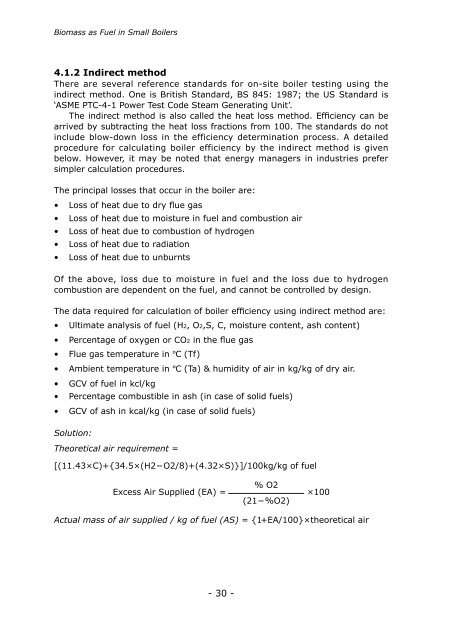Biomass as Fuel in Small Boilers (PDF 6.4 - APO Asian Productivity ...
Biomass as Fuel in Small Boilers (PDF 6.4 - APO Asian Productivity ...
Biomass as Fuel in Small Boilers (PDF 6.4 - APO Asian Productivity ...
Create successful ePaper yourself
Turn your PDF publications into a flip-book with our unique Google optimized e-Paper software.
<strong>Biom<strong>as</strong>s</strong> <strong>as</strong> <strong>Fuel</strong> <strong>in</strong> <strong>Small</strong> <strong>Boilers</strong><br />
4.1.2 Indirect method<br />
There are several reference standards for on-site boiler test<strong>in</strong>g us<strong>in</strong>g the<br />
<strong>in</strong>direct method. One is British Standard, BS 845: 1987; the US Standard is<br />
‘ASME PTC-4-1 Power Test Code Steam Generat<strong>in</strong>g Unit’.<br />
The <strong>in</strong>direct method is also called the heat loss method. Efficiency can be<br />
arrived by subtract<strong>in</strong>g the heat loss fractions from 100. The standards do not<br />
<strong>in</strong>clude blow-down loss <strong>in</strong> the efficiency determ<strong>in</strong>ation process. A detailed<br />
procedure for calculat<strong>in</strong>g boiler efficiency by the <strong>in</strong>direct method is given<br />
below. However, it may be noted that energy managers <strong>in</strong> <strong>in</strong>dustries prefer<br />
simpler calculation procedures.<br />
The pr<strong>in</strong>cipal losses that occur <strong>in</strong> the boiler are:<br />
• Loss of heat due to dry flue g<strong>as</strong><br />
• Loss of heat due to moisture <strong>in</strong> fuel and combustion air<br />
• Loss of heat due to combustion of hydrogen<br />
• Loss of heat due to radiation<br />
• Loss of heat due to unburnts<br />
Of the above, loss due to moisture <strong>in</strong> fuel and the loss due to hydrogen<br />
combustion are dependent on the fuel, and cannot be controlled by design.<br />
The data required for calculation of boiler efficiency us<strong>in</strong>g <strong>in</strong>direct method are:<br />
• Ultimate analysis of fuel (H2, O2,S, C, moisture content, <strong>as</strong>h content)<br />
• Percentage of oxygen or CO2 <strong>in</strong> the flue g<strong>as</strong><br />
• Flue g<strong>as</strong> temperature <strong>in</strong> ºC (Tf)<br />
• Ambient temperature <strong>in</strong> ºC (Ta) & humidity of air <strong>in</strong> kg/kg of dry air.<br />
• GCV of fuel <strong>in</strong> kcl/kg<br />
• Percentage combustible <strong>in</strong> <strong>as</strong>h (<strong>in</strong> c<strong>as</strong>e of solid fuels)<br />
• GCV of <strong>as</strong>h <strong>in</strong> kcal/kg (<strong>in</strong> c<strong>as</strong>e of solid fuels)<br />
Solution:<br />
Theoretical air requirement =<br />
[(11.43×C)+{34.5×(H2-O2/8)+(4.32×S)}]/100kg/kg of fuel<br />
Excess Air Supplied (EA) =<br />
% O2<br />
(21-%O2)<br />
×100<br />
Actual m<strong>as</strong>s of air supplied / kg of fuel (AS) = {1+EA/100}×theoretical air<br />
- 30 -
















